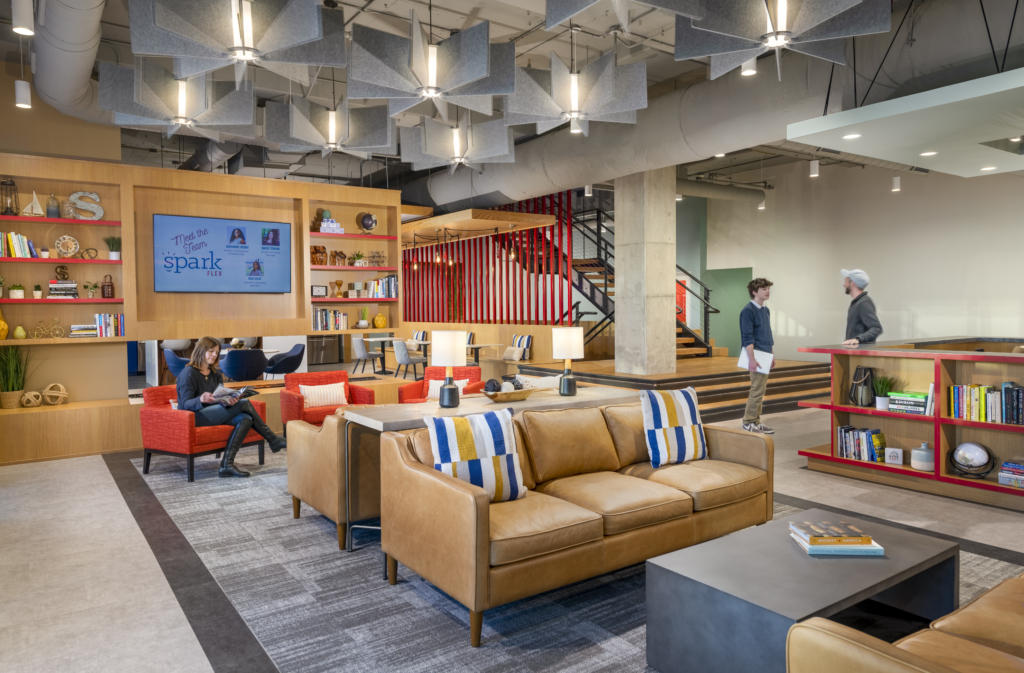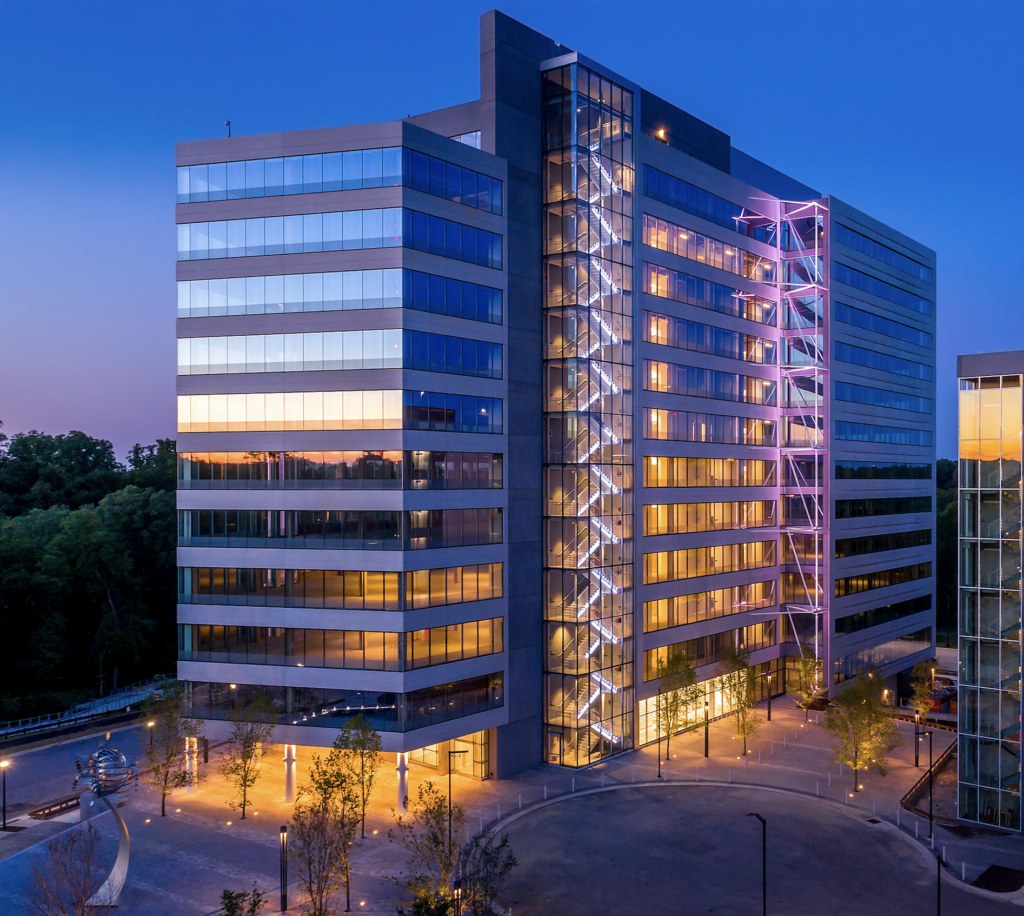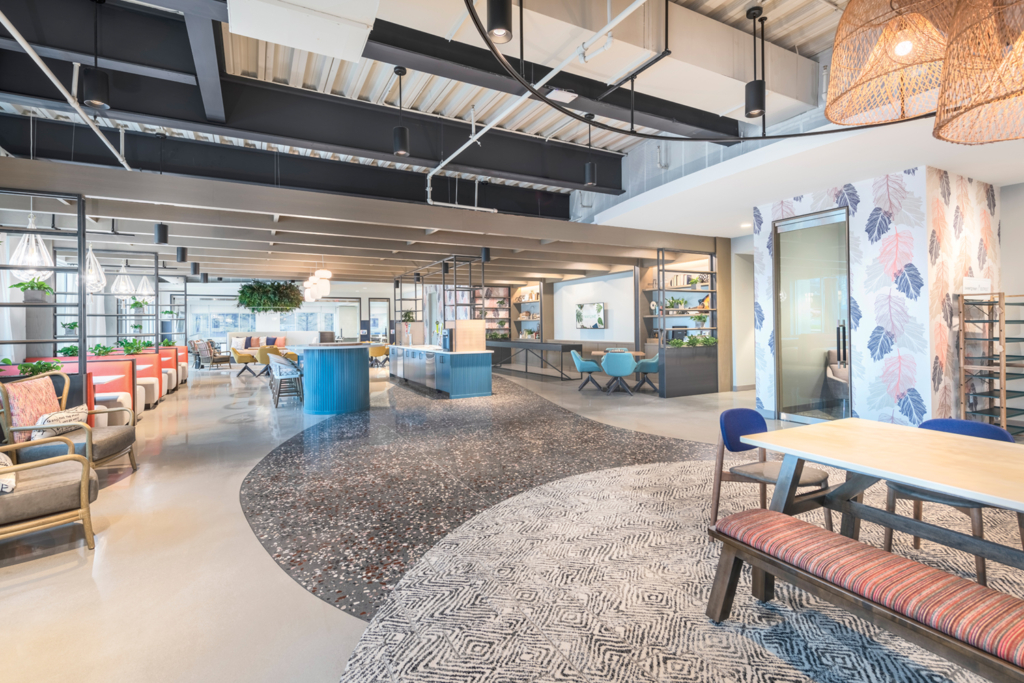The bright red accents, feature staircase, café seating, posh lounge, artful lighting, industrial touches and city views create the feel of a super cool, luxurious and oh so inviting coffee shop.

Spark Flex combines coworking and traditional office space with a wealth of amenities, including an inviting library/lounge/coffee bar. Photo courtesy of The Verve Partnership.
The space, however, is a common area in Spark Flex – a hybrid of coworking and traditional office space in downtown Baltimore. Developed by The Cordish Companies and designed by The Verve Partnership, Spark Flex provides a range of shared amenities – collaborative spaces, AV-enabled meeting rooms, a podcast studio, shared kitchen, coffee/tea bar, library/lounge, waterfront balconies, gym access and a wellness/mother’s room. Surrounding those amenities are custom-built, Class A office suites, ranging from 1,200 to 5,000 square feet and offering key conveniences, including in-house IT-setup and office-design support, onsite garage and leases as short as 18 months.
“I think Spark Flex is a game changer,” said Kelly Ennis, Founding and Managing Principal at The Verve Partnership.
The property, Ennis said, provides office tenants with the support and flexibility they need in a demanding and uncertain economy as well as the amenities and environment that can entice employees back to the office.
“We used to talk about ROI. Now it’s ROC: What’s the return on your commute? Offices have to provide good ROC to attract workers,” she said.
Shifting work trends have heightened the bar for what constitutes a truly attractive office. The popularity of remote- and hybrid-work has accelerated three pre-pandemic trends: the flight to quality, the desire for various collaborative and creative workspaces, and the popularity of office properties within walking distance of restaurants, retail, residences and recreational spaces. Those desires combined with high construction costs and reduced office demand create a clear challenge. But some owners and developers are finding ways to succeed, even with older and smaller properties.
While many companies are looking to downsize their space, current preferences are also creating opportunities in the office market, said Terri Harrington, Managing Partner, Harrington Commercial Real Estate Services.
In addition to being willing to pay for higher quality office space, “businesses are leaning towards places that feel like Starbucks and can get employees off their kitchen tables and back into their offices, but not to sit at a single desk all day long… Employees want access to a variety of work environments. Some companies want space that is completely different than what they have been in for the past 20 years – something that feels like a fresh start,” she said.

Office tenants are increasingly willing to pay for shared amenities, such as those at 6100 Merriweather Drive. Photo courtesy of Howard Hughes Corporation.
While Baltimore Peninsula, Canton Crossing, office towers in the Merriweather District and other new developments have been designed to meet today’s standards, property owners are also renovating older buildings to increase their appeal.
Extensive renovations of 100 Light Street have attracted three new tenants to the property in the past six months, despite a very soft office market in the central business district. COPT renovated the full-floor café on the 17th story to include a variety of seating and a games area, and upgraded the 18th floor fitness center to provide 4,500 square feet of high-end workout opportunities (including a suite of Peloton bikes) with a harbor view. It expanded the 100-person conference center by adding pre-conference space that enables tenants to add secondary gatherings, breakout sessions and parties to their conferences.
COPT also renovated Lumen Plaza “with modern conveniences and a higher level of security in mind,” said John Hermann, Vice President, Asset Management + Leasing at COPT. “The plaza has seating areas with built-in device chargers and bike racks with built-in repair tools. The landscaping and hardscaping were selected with sightlines in mind to enhance building security and our opportunity to surveil the property, which is very important in a downtown setting. You can’t overstate the importance of security. It only takes one small incident to taint a property so security is a big part of our operating budget and our capital investment.”
Some security measures double as amenities to tenants, Hermann said. For example, 100 Light Street’s access control systems monitor usage of the underground parking garage. That same system also enables tenants to check parking availability for visitors and send QR codes to their guests which provide them access to the garage and appropriate parts of the building.
Stand-alone office towers, however, are not the only properties that can satisfy current standards for truly attractive offices. In Columbia, COPT took a different approach to its low-rise, business park holdings.
COPT’s 28 buildings in Columbia Gateway total 2.3 million square feet and present ample space to provide attractive amenities “but tenants are not going to drive from one building to another to work out or get a cold brew,” said Krysta Herring, Vice President, Asset Management + Leasing.

Office tenants are increasingly willing to pay for shared amenities, such as those at Wayline. Photo courtesy of Corporate Office Properties Trust.
So, COPT turned clusters of buildings into micro-communities with shared amenities and walkable spaces between them. For example, tenants at the three-building Wayline campus now have access to an 8,000-square-foot common amenity space, which includes a fitness center with a Peloton room, yoga lawn, half-court basketball and a terrace (called The Alley) that features restaurant-style seating, ample lighting and a food truck court, Herring said.
The campus and amenities satisfy employers’ need for “really memorable, cool spaces that hook employees into coming into the office,” she said.
Similarly, Howard Hughes Corporation has found ways to make its older buildings meet modern office desires.
A $10 million renovation has transformed seven older buildings along Little Patuxent Parkway into Merriweather Row. Refreshed building exteriors, enhanced landscaping, new lighting and construction of plaza areas have made the property more attractive and improved connections between the buildings. In addition, Howard Hughes created two tenant amenity hubs which each include fitness centers, lounges and conferencing facilities.
Greg Fitchitt, President for the Columbia, MD region for Howard Hughes Corporation, said the shared amenities at newly constructed and renovated properties are popular with tenants to the point that tenants are willing to pay higher common area fees.
“We have found that it is easy to make the argument to tenants that they should pay a portion of expenses for common amenities,” Fitchitt said. “These can be pretty significant spaces from 1,000 to 2,000 square feet. If they were within the tenant space, it would be an expense and they might only use them once or twice a month, so they see a lot of value in this arrangement.”